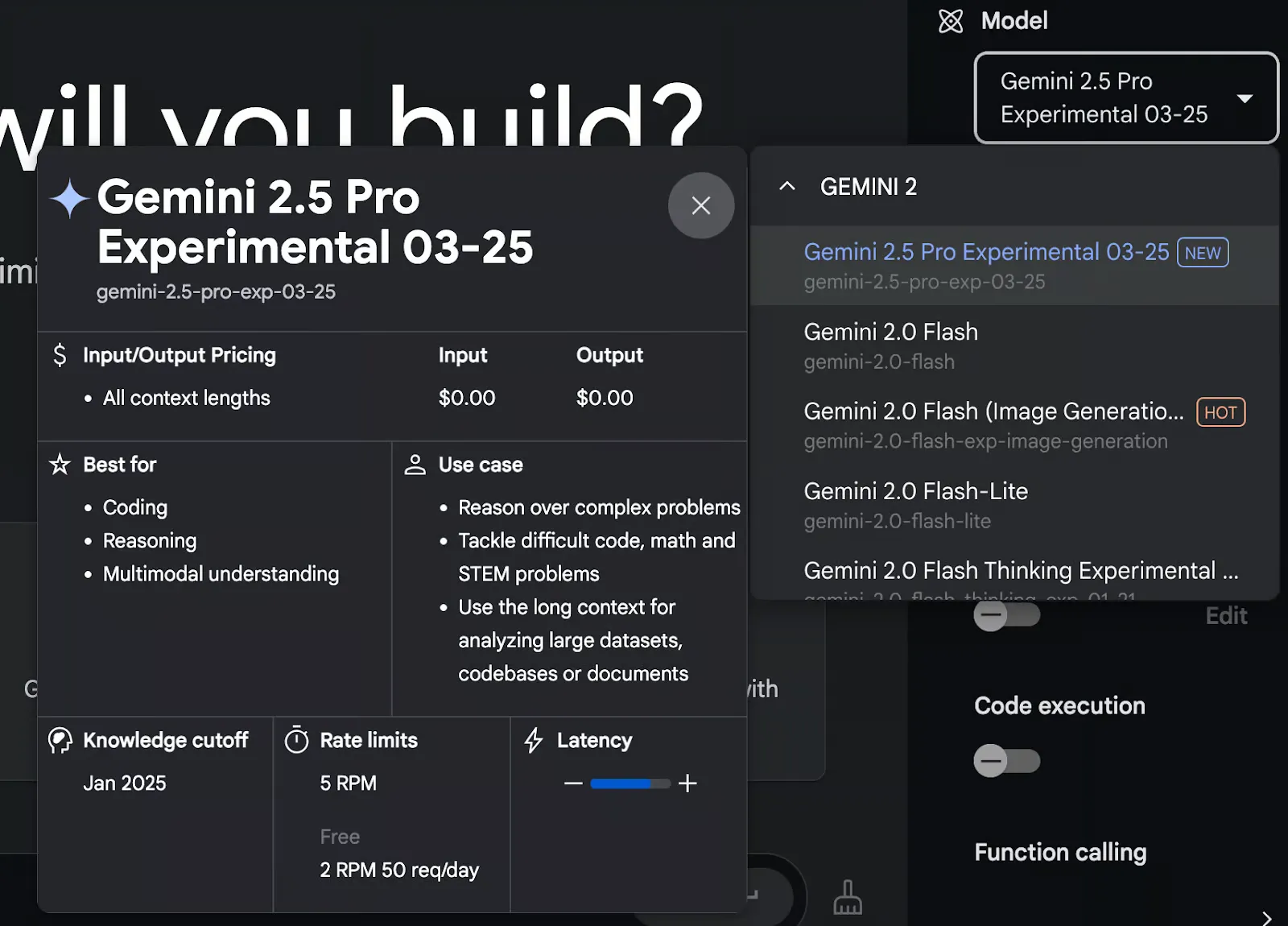Explore the Power of Gemini 2.5 Pro: Google's Most Advanced AI Yet
Takeaways
- Launched: Early 2025 by Google DeepMind, featuring a massive 1 million token context window (soon 2 million). It handles complex reasoning, multimodal inputs (text, images, audio, video), and large documents better than most AI models today.
- Who it’s for: Developers, researchers, content creators, and businesses needing smarter, faster AI for complex tasks.
- Why It’s Popular: Topping AI leaderboards, Gemini 2.5 Pro is favored by developers and businesses for its unmatched versatility and performance.
- Available on: Gemini Advanced plans, Google AI Studio, and soon on Vertex AI.
Google has recently launched Gemini 2.5 Pro, their smartest AI model yet! As the first in the Gemini 2.5 series, it comes with a groundbreaking 1 million token context window (soon expanding to 2 million), setting a new benchmark in AI.
With this level of context, Gemini 2.5 Pro can handle complex tasks that other models can’t, such as processing and analyzing large codebases and performing advanced data modeling. And it’s not just hype: Google claims it’s already secured the #1 spot on the LMArena leaderboard, particularly in segments like math, creative writing, instruction following, and problem solving and has seen an 80% increase in usage among developers in just one month.
Here’s what you need to know about Gemini 2.5 Pro, highlighting its key features and its impact on setting new benchmarks in the AI industry.
What Is Gemini 2.5 Pro?
Gemini 2.5 Pro is Google's most advanced multimodal AI model, launched ahead of the Google I/O 2025 conference. Available to Gemini Advanced plan users and through Google AI Studio (experimental), it’s designed to offer the best reasoning capabilities yet.
The model uses advanced reasoning abilities, meaning it doesn’t just throw out random answers. It thinks through problems, breaking them down to give more accurate, reliable responses. With improvements in tool use, multimodal input handling, and long-context performance, Gemini 2.5 Pro tackles complex tasks with far more precision than its competitors. Here’s a quick look at what it supports:
What Can Gemini 2.5 Pro Do?

Like other AI models, Gemini 2.5 Pro helps with a variety of tasks, but what sets it apart is its large context window, smart reasoning, and ability to handle all types of data. It’s built to help you work faster and smarter, no matter what you do, whether you write code, do research, create content, or run a business.
Here's how it can help:
1. Smarter Reasoning & Complex Problem Solving
- Breaks down complex problems step-by-step
- Delivers clear, context-aware responses
Use Cases: Data analysis, Scientific research, Solving logic or math problems
Ideal For: Researchers, students, scientists, analysts
2. Advanced Coding Assistance
- Generates clean, functional code from simple prompts
- Debugs in real time and builds complete applications
- Ranks #1 in front-end development benchmarks
Use Cases: Building web apps, video games, Code generation and error detection
Ideal For: Developers, engineers, QA teams
3. Native Multimodal Content Processing
- Understands and generates content across text, images, audio, video, and code
- Analyzes media-rich content in one go
Use Cases: Turning a video into a learning module, Analyzing text with images or audio
Ideal For: Content creators, educators, designers
4. Handling Large Context Window
- Processes up to 1 million tokens (and growing)
- Handles long documents, codebases, or conversations without losing context
Use Cases: Reading entire books or reports, Analyzing large codebases or logs
Ideal For: Enterprises, analysts, legal teams, and authors
5. Tool Integration & Workflow Automation
- Effortlessly connects with external tools and apps
- Automates coding, data tasks, reporting, and more
Use Cases: Automating IT tasks, Building smart applications
Ideal For: Developers, IT teams, operations, and product managers
6. Faster Data Processing & Insights
- Handles large datasets in real time
- Accelerates machine learning workflows and decision-making
Use Cases: Rapid insight generation, Business intelligence, and ML model analysis
Ideal For: Data scientists, business leaders, and product teams
7. Real-Time Error Detection & Debugging
- Identifies and suggests fixes for code issues on the fly
- Improves release speed and code quality
Use Cases: Live debugging and QA, Reducing post-deployment bugs
Ideal For: Developers, QA engineers, and dev teams
8. Personal Productivity Booster
- Breaks down projects into tasks
- Helps manage schedules, write emails, or handle support queries
Use Cases: Task planning, Workflow management, Virtual assistant functionality
Ideal For: Professionals, entrepreneurs, and busy individuals
How Does Gemini 2.5 Pro Compare to Other AI Models?
Google's Gemini 2.5 Pro has demonstrated exceptional performance across various benchmarks, outperforming several top AI models in key areas. Here's how it compares:
Note: Higher percentages indicate better performance on respective benchmarks.
- Knowledge and Reasoning: Gemini 2.5 Pro scored 18.8% higher than its competitors in the Humanity’s Last Exam, showing its strength in handling complex topics. (Humanity’s Last Exam is a benchmark for testing AI's reasoning and ability to solve complex, abstract problems.)
- Coding: Gemini performs well but slightly trails Claude 3.7 Sonnet on some coding benchmarks. It still offers excellent real-time error detection and code generation.
- Long Contexts and Multimodal Tasks: With a 91.5% score on MRCR, Gemini excels at handling long documents and multimodal inputs like text, images, audio, and video, outperforming GPT-4.5 and others.
- Math and Science: Gemini’s strong performance on AIME benchmarks makes it a solid choice for users needing advanced mathematical and scientific problem-solving.
This makes Gemini 2.5 Pro an incredibly powerful tool for businesses, developers, and researchers seeking advanced AI capabilities.
Gemini 2.5 Pro Pricing: What You Need to Know
Gemini 2.5 Pro is currently available for free in its experimental version, but with some usage limits. If you’re looking to explore more features—like higher token limits, faster performance, or access via APIs—you’ll need to switch to a paid plan.
Below is a quick overview of the paid-tier pricing (per 1 million tokens):
Note: These prices apply when you're using Gemini 2.5 Pro through tools like Google AI Studio or Vertex AI, as part of the Gemini Advanced plan (included in the Google One AI Premium subscription).
Bonus for Students: If you're a college student in the U.S., you can access Gemini Advanced for free through finals in 2026.
Gemini 2.5 Pro vs Other AI Models: Price Comparison
Here’s a quick look at how Gemini 2.5 Pro’s pricing compares with other popular AI models:

While Gemini 2.5 Pro isn't the cheapest option, its advanced features and performance make it a solid choice for developers and researchers. Compared to other models, it offers great value with a large context window and multimodal support.
If you need advanced power, models like GPT-4o and Claude 3.7 cost more, while DeepSeek v3 and o3-mini are budget-friendly for smaller tasks.
Gemini 2.5 Pro Review: What Users Are Saying
Gemini 2.5 Pro has received mixed but generally positive feedback across online communities. Many developers appreciate its advanced coding assistance, ability to handle large documents without losing context, and its ease in creating complex apps from simple prompts. However, some users have also pointed out occasional performance issues during extended conversations and mentioned that the pricing feels a bit steep.
- Enhanced Coding Capabilities: Many developers praise Gemini 2.5 Pro for its sophisticated coding support. One Reddit user commented,
"The intelligence level seems to be better than o1 and around the same ballpark as o1-pro (or maybe just slightly less). But the biggest feature, in my opinion, is how well it understands the intent of the prompts."
- Impressive Performance with Large Documents: Users have noted that Gemini 2.5 Pro excels at managing extensive documents. As one Reddit user shared,
"In my case (legal document generation tasks), it's performing way better: No weird errors, it sticks properly to the context of uploaded documents, it fully utilizes the 200k+ context window without falling apart."
- Performance Variability: Some users have reported inconsistencies. For example, a Reddit user mentioned,
"Gemini 2.5 Pro is less competent than Gemini 2.5 Flash on tasks that don't require code."
- Issues with Long Conversations: Another user pointed out,
"Biggest oof I've had with Gemini 2.5 Pro is after a chat gets really long, Gemini 2.5 will mix up responses as if traveling through time."
For a detailed review, you can check out this in-depth Gemini 2.5 Pro coding review on YouTube, which highlights both its strengths and limitations.
How to Access Gemini 2.5 Pro
Gemini 2.5 Pro is available globally, supporting 38 languages across 180+ countries. Here’s how you can get started, depending on what you want to do:
- Gemini App

The easiest way to access Gemini 2.5 Pro is through the Gemini app (available on mobile and web). If you're a Gemini Advanced subscriber, simply select Gemini 2.5 Pro from the model dropdown menu to start experimenting.
- Gemini 2.5 Pro API
If you want to integrate Gemini 2.5 Pro into your app or workflow, use the Gemini API. It allows direct calls to the model, enabling tool use and structured responses for tasks like processing long documents or automating processes.
- Google AI Studio

If you want more control over inputs, tool use, or multimodal prompts, Google AI Studio is the solution for you.
It’s free to use and supports text, images, audio, and video inputs. You can upload large files and test custom workflows. After creating an account, select Gemini 2.5 Pro from the model dropdown to get started.
- Gemini 2.5 Pro on Vertex AI
Gemini 2.5 Pro will soon be available on Vertex AI, which is a part of Google Cloud. The main difference between using the Gemini API directly and accessing it through Vertex AI is the scale, infrastructure, and integration options.
If you're testing or working on internal tools, AI Studio or the API will work well. But for production environments with specific performance or security needs, Vertex AI will be the best option. For more technical details, check here.
Final Words
With so many AI models being released, it’s hard to be impressed anymore. Most follow the same pattern with big claims and flashy benchmarks. But Gemini 2.5 Pro truly stands out.
It’s a game-changer for developers and businesses, with advanced coding, reasoning, and multimodal features. The upcoming 2 million token context window will make it even more practical for real-world tasks. And Google isn’t stopping here—future updates will make it even more powerful, handling larger datasets and more complex tasks.
If you're a business looking to stay ahead in the AI space, your content must be not only created but also understood by these advanced AI models. After all, AI is only effective if it can engage with your content properly. Gushwork’s AI Visibility Suite is the solution. It optimizes your content for models like Gemini 2.5 Pro and ChatGPT and helps your business stay visible and competitive.
Check it out and be among the first businesses that AI truly understands!


















.webp)








.webp)

.svg)


.svg)
.svg)
.svg)







.svg)